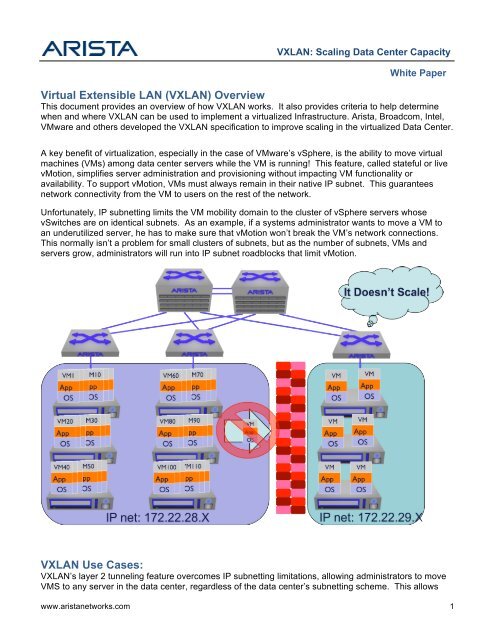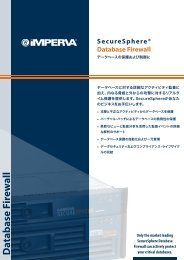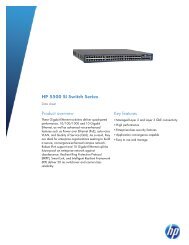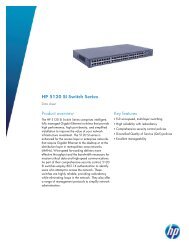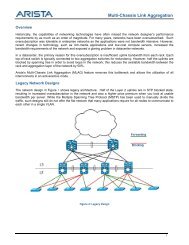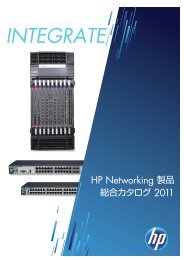Virtual Extensible LAN (VXLAN) Overview VXLAN Use ... - tecnologika
Virtual Extensible LAN (VXLAN) Overview VXLAN Use ... - tecnologika
Virtual Extensible LAN (VXLAN) Overview VXLAN Use ... - tecnologika
You also want an ePaper? Increase the reach of your titles
YUMPU automatically turns print PDFs into web optimized ePapers that Google loves.
VX<strong>LAN</strong>: Scaling Data Center CapacityWhite Paper<strong>Virtual</strong> <strong>Extensible</strong> <strong>LAN</strong> (VX<strong>LAN</strong>) <strong>Overview</strong>This document provides an overview of how VX<strong>LAN</strong> works. It also provides criteria to help determinewhen and where VX<strong>LAN</strong> can be used to implement a virtualized Infrastructure. Arista, Broadcom, Intel,VMware and others developed the VX<strong>LAN</strong> specification to improve scaling in the virtualized Data Center.A key benefit of virtualization, especially in the case of VMware’s vSphere, is the ability to move virtualmachines (VMs) among data center servers while the VM is running! This feature, called stateful or livevMotion, simplifies server administration and provisioning without impacting VM functionality oravailability. To support vMotion, VMs must always remain in their native IP subnet. This guaranteesnetwork connectivity from the VM to users on the rest of the network.Unfortunately, IP subnetting limits the VM mobility domain to the cluster of vSphere servers whosevSwitches are on identical subnets. As an example, if a systems administrator wants to move a VM toan underutilized server, he has to make sure that vMotion won’t break the VM’s network connections.This normally isn’t a problem for small clusters of subnets, but as the number of subnets, VMs andservers grow, administrators will run into IP subnet roadblocks that limit vMotion.VX<strong>LAN</strong> <strong>Use</strong> Cases:VX<strong>LAN</strong>’s layer 2 tunneling feature overcomes IP subnetting limitations, allowing administrators to moveVMS to any server in the data center, regardless of the data center’s subnetting scheme. This allowswww.aristanetworks.com 1
administrators to implement a reliable L3 architecture in the data center while also supporting VMmobility across all the servers in the data center.Application Examples:• Hosting provider provisioning a cloud for its customer• VM Farm that has outgrown its IP address space but wants to preserve the data centernetwork architecture• Cloud service provider who’s multi-tenant offering needs to scale beyond 802.1q V<strong>LAN</strong>S.Fundamentally, VX<strong>LAN</strong> provides mechanisms to aggregate and tunnel multiple layer 2 (sub)networksacross a Layer 3 infrastructure. The VX<strong>LAN</strong> base case is to connect two or more layer three networkdomains and make them look like a common layer two domain. This allows virtual machines on differentnetworks to communicate as if they were in the same layer 2 subnet.Using <strong>Virtual</strong> Tunnel End Points (VTEPs) to transport multiple virtual networksVX<strong>LAN</strong> Implementation:The network infrastructure must support the following to support VX<strong>LAN</strong>S:• Multicast support: IGMP and PIM• Layer 3 routing protocol: OSPF, BGP, IS-ISFor the most part, networking devices process VX<strong>LAN</strong> traffic transparently. That is, IP encapsulatedtraffic is switched or routed as any IP traffic would be. VX<strong>LAN</strong> gateways, also called <strong>Virtual</strong> Tunnel EndPoints (VTEP), provide the encapsulating/de-encapsulating services central to VX<strong>LAN</strong>. VTEPS can bevirtual bridges in the hypervisor, VX<strong>LAN</strong> aware VM applications or VX<strong>LAN</strong> capable switching hardware.VTEPs are key to virtualizing networks across the existing data center infrastructure.www.aristanetworks.com 2
Well, not really!Each VX<strong>LAN</strong> network segment is associated with a unique 24bit VX<strong>LAN</strong> Network Identifier, or VNI. The24 bit address space allows scaling virtual networks beyond the 4096 available with 802.1Q to 16.7million possible virtual networks. However, multicast and network hardware limitations will reduce theuseable number of virtual networks in most deployments. VMs in a logical L2 domain use the samesubnet and are mapped to a common VNI. It’s the L2 to VNI mapping that lets VMs communicate withone another. Note that VX<strong>LAN</strong> doesn’t change layer 3 addressing schemes. IP addressing rulesemployed in a physical L2 still apply to the virtual networks.VX<strong>LAN</strong>s maintain VM identity uniqueness by combining the VM’s MAC address and its VNI. This isinteresting because it allows for duplicate MAC addresses to exist in a datacenter domain. The onlyrestriction is that duplicate MACs cannot exist on the same VNI.<strong>Virtual</strong> machines on a VNI subnet don’t require any special configuration to support VX<strong>LAN</strong> because theencap/decap and VNI mapping are managed by the VTEP built into the hypervisor. VX<strong>LAN</strong> capableswitching platforms are similarly responsible for the encap/decap overhead of 802.1q attached networkdevices. The VTEP must be configured with the layer 2 or ip subnet to VNI network mappings as well asVNI to IP multicast groups. The former mapping allows VTEPS to build forwarding tables for VNI/MACtraffic flows and the latter allows VTEPs to emulate broadcast/multicast functions across the overlaynetwork. Synchronization of VTEP configurations can be automated with common configurationmanagement tools like RANCID, or they can be managed through VMware’s vCenter Orchestrator, OpenvSwitch or other systems.VX<strong>LAN</strong> frame encapsulation and forwarding:With these elements in place, the VTEP executes its forwarding rules:1) If the source and destination MAC addresses live on the same host, traffic is locally switchedthrough the vSwitch and no VX<strong>LAN</strong> encap/decap is performed.2) If the destination MAC address live is not on the ESX host, frames are encapsulated in theappropriate VX<strong>LAN</strong> header by the source VTEP and are forwarded to the destination VTEPbased on its local table. The destination VTEP will unbundle the inner frame from the VX<strong>LAN</strong>header and deliver it on to the recipient VM.3) For unknown unicast or broadcast/multicast traffic, the local VTEP encapsulates the frame in aVX<strong>LAN</strong> header and multicasts the encapsulated frame to the VNI multicast address that isassigned to the VNI at the time of creation. This includes all ARPs, Boot-p/DHCP requests, etc.www.aristanetworks.com 3
VTEPs on other hosts receive the multicast frame and process them much the same way unicasttraffic is (see note 2 above).The implementation of this tunneling scheme is relatively simple compared to other schemes, such asMPLS or OTV, because the administrator only needs to configure VNI or IP mappings and multicastaddresses. The rest is managed by the VTEPs.Here are additional details of the frame format:VX<strong>LAN</strong> header formatEthernet header:Destination address - This is set to the MAC address of the destination VTEP if its on the samesubnet. If the VTEP is on a different subnet the address is set to the next hop device, usually a router.V<strong>LAN</strong> -This is optional for a VX<strong>LAN</strong> implementation. It will default to the 802.1Q Tagged PrototocolIdentifier (TPUD) Ethertype 0X8100 and has an associated V<strong>LAN</strong> ID tag.Ethertype –This is set to 0X0800 to denote an IPv4 payload packet. There’s currently no IPV6 supportyet but it’s under investigation future deployment.IP Header:Protocol –This is set to 0 ! 11 to indicate it’s a UDP packet.Source IP –This is set to the VTEP source IP addressDestination IP – This is set to the destination VTEP IP address. If unknown/unlearned or is abroad/multi-cast address, then VX<strong>LAN</strong> simulates a network broadcast using its multicast group. Here’s abrief outline:a) Destination IP is replaced by the IP multicast group that corresponds to the VNI of the sourcevirtual machine.b) Frame is multicast and All VTEPs on the VNI multicast group receive the frame. They in turnunbundle the frame, learn the source ID and VNI mapping for future use and then forward or dropthe packet based on the frame type and local forwarding table information.c) The VTEP hosting the target virtual machine will encapsulate and forward the virtual machinesreply to the sourcing VTEP.d) The source VTEP receives the response and also caches the ID and VNI mapping for future use.UDP header:Source Port -Set by transmitting VTEP. This value can be hashed from the bundled Ethernet headersso that port channel or ecmp hashing algorithms can leverage this value for traffic balancing.www.aristanetworks.com 4
VX<strong>LAN</strong> Port -VX<strong>LAN</strong> IANA port. Vendor specific.UDP Checksum - Should be set by VTEP source to 0 ! 0000. If the receiving VTEP receives achecksum that isn’t 0 ! 0000, the frame should be checked and discarded if checksum fails.VX<strong>LAN</strong> Header:VX<strong>LAN</strong> Flags - Aside from bit 3, the VNI bit, all reserved bits set to zero. The VNI bit is set to 1 for avalid VNI.VNI –This 24-bit field is the VX<strong>LAN</strong> network ID.Reserved – Reserved fields of 24 and 8 bits that are set to zero.VX<strong>LAN</strong> packet walkthrough:VX<strong>LAN</strong>: VM to VM communicationHere’s a packet walkthrough of a session initiated between VMs 1 and 2 residing on different hosts indifferent IP subnets. We assume bring up state: no associations have been learned yet.• VM1 sends an ARP packet requesting the MAC address associated with 192.168.0.101.• The ARP is encapsulated in a Multicast packet by VTEP1 and is multicast to the groupassociated to VNI 864.• All VTEPs associated with VNI 864 receive the packet and add the VTEP1/VM1 MAC mapping totheir tables• VTEP2 receives the multicast packet, unbundles the frame and floods it to the port groups in VNI864.• VM2 receives the ARP and responds to VM1 with its MAC address.www.aristanetworks.com 5
• VTEP2 encapsulates the response as a unicast IP packet and forwards it to VTEP1. Theresponse is unicast since VTEP 2 has learned the VTEP1/VM1 MAC mapping from the originalsimulated ARP.• VTEP1 receives, unbundles and forwards the response packet to VM1.At this point, communications between VM1 and 2 are established and associations are programmedinto all relevant state machines. For any further unicast traffic being sourced from 192.168.0.100destined to 192.160.0.101, VTEP 1 will take the packet and prepend the following headers:a. VNI VX<strong>LAN</strong> header = 864.b. Standard UDP header with the UDP checksum set to 0 ! 0000 and the VX<strong>LAN</strong>destination port set to the correct IANA port based on vendor.c. Destination IP set to the IP address of VTEP 2 and the protocol ID set to UDP, or 0x011.d. Standard MAC header with the next hop MAC address. (In the above example, the nexthop is the router interface with MAC address 00:13:73: 0C: 76: 24.)VTEP2 will receive the packet by way of the intermediary router. The unbundling process is triggered bythe UDP header value. VTEP 2 now passes the frame to the Vswitch and port groups mapped to VNI864. The frame is then switched to VM2 for processing. All return traffic is processed in a mirror of theabove example.Implementation Considerations:Network datagram payloads and bandwidth utilization:The VX<strong>LAN</strong> encapsulation header adds 50 bytes to the overall size of an Ethernet frame. Therefore it isimperative the infrastructure support jumbo frames. One should also consider the increased bandwidthused to support VX<strong>LAN</strong> traffic. Juxtaposing multiple networks with an increased packet size willconsume more bandwidth so its prudent to implement this scheme over 10Gb or higher capacity networktechnologies.Using standard IP datagrams helps VX<strong>LAN</strong> offer options for implementing long distance vMotion or HighAvailability (HA). VX<strong>LAN</strong> frames even take information from the embedded packet to add variability in itspacket header to aid load-sharing algorithms. However, if the network designer is interested inleveraging VX<strong>LAN</strong>s in disaster recovery or remote mirrored data center applications, its important toensure that VMWare vMotion/HA heartbeat round trip delay not exceed 10 milliseconds. Designers canleverage high bandwidth, low latency switching with traffic prioritization services to fulfill theserequirements and extend the virtualized data center.Multicast requirements:As previously mentioned, IP multicast services are used to simulate broadcast, unknown unicast andmulticasts within the VX<strong>LAN</strong> network. This is required for VX<strong>LAN</strong>s. While not required, the currentrecommended configuration is to map one multicast group to each VNI. This ensures MAC tableupdates are only sent to VTEPs that require them. It is possible to use only one multicast address forevery VNI, but this will effectively flood addresses to VTEPs not needing them and create unnecessarytraffic flows in the network.PIM sparse, dense mode and BIDIR all provide multicast capabilities to support VX<strong>LAN</strong>s. While someadministrators have concerns with PIM, especially those who experienced network outages due to CPUbound PIM processing, its important to note that modern switching platforms support PIM in hardwareand can support large scale PIM deployments without adversely impacting the performance or reliabilityof the network.www.aristanetworks.com 6
ARP cache and MAC table considerations:VMs in a VX<strong>LAN</strong> Network communicate to non-virtual networks through a VTEP. VTEPs can either be asoftware appliance, like a virtual firewall or VMware vShield, or in a VX<strong>LAN</strong> capable switch. In eithercase, if the VTEP provides routing services, the ARP cache must accommodate the number of VMs onthe virtual networks it services to avoid unnecessary ARPS.VM traffic encapsulated in VX<strong>LAN</strong> frames use the MAC IDs of the server’s VTEP. This reduces thenumber of MAC address entries in the data center’s physical switches. Ideally, a physical VX<strong>LAN</strong>network would only be required to learn the MAC addresses for the VTEPs and management interfacesof the hosts within the data center. However, while this may work in smaller scale VM deployments, it isprudent to partition VMs and server clusters in subnets to accommodate the traffic volumes sustainablewith up to dozens of VMs per server.Summary table of capabilities:Feature and scaling capability 802.1Q V<strong>LAN</strong> VX<strong>LAN</strong>Number of virtual networks 4K: limited by spanning treescaling16+ million: limited by thenumber of multicast groupssupported by your network’smulticast routersAs far as PIM Mcast groups arepermittedNetwork diameterAs far as 802.1Q V<strong>LAN</strong>S arepermittedNetwork packet size 1.5K or 9K Add 50 bytes for VX<strong>LAN</strong> headerMulticast requirements None PIM, SM, DM, or Bidir. Numberof groups defines number ofvirtual networksRouting supportARP CacheMac tableAny 802.1Q capable router orswitchLimits the VMs supported perV<strong>LAN</strong>VM MAC addresses countagainst switch MAC table limitsAny router or switch working withVmware vShield, vEdge and anyVTEP capable routerCache on vmWare or VTEPslimits VMs supported per VNIVTEP MAC addresses countagainst switch MAC table limitsSummary:VX<strong>LAN</strong> is a powerful tool for extending layer 2 subnets across layer 3 network boundaries. It solves VMportability/vMotion limitations by encapsulating traffic and extending it across L3 gateways, allowing VMsto be hosted by servers residing on foreign IP subnets. VX<strong>LAN</strong>s can also overlay multiple subnetsacross a data center infrastructure. The number of virtual networks is limited only by the raw bandwidthof the underlying network and the multicast subnets available to simulate broadcast/multicast traffic ofthe VX<strong>LAN</strong> network. Given the right hardware, VX<strong>LAN</strong>S can eclipse the 4K V<strong>LAN</strong> limit of 802.1Qwithout compromising the stability of the network. VX<strong>LAN</strong>s use established IP transport along withrouting for encapsulated traffic. Therefore, link aggregation, loop detection and breaking, and pathdiscovery are resolved through tried and proven OSPF, BGP or IS-IS protocols. VX<strong>LAN</strong>s can work onexisting infrastructures without the need to retrofit them. Support from VMware, Intel, Broadcom, Arista,Open vSwitch and others guarantees interoperability and avoids vendor lock in. With VX<strong>LAN</strong>s, systemsand network administrators can scale cloud virtualization to new levels and serve more users costeffectively.For more information, please visit www.aristanetworks.comwww.aristanetworks.com 7


